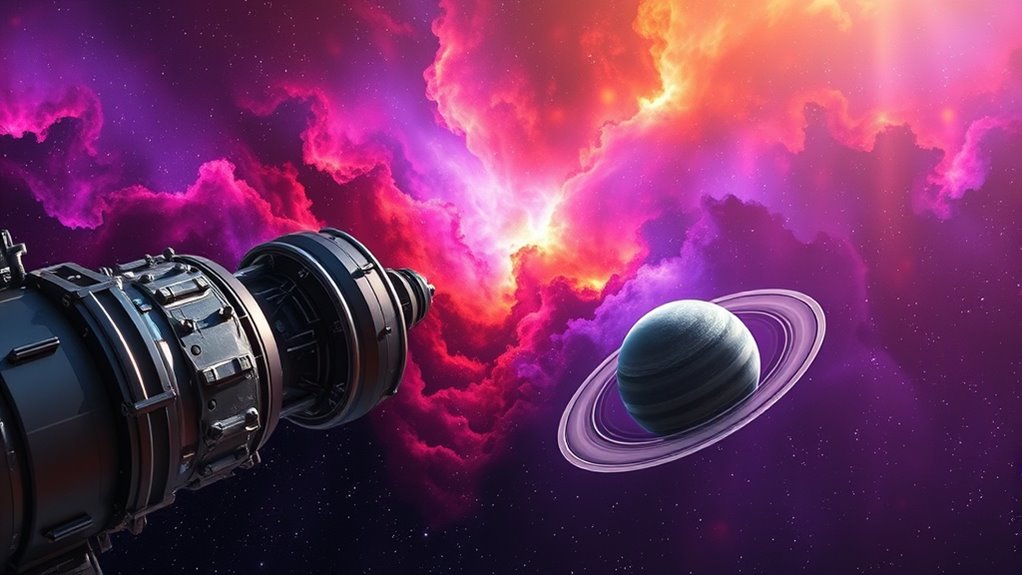In 2025, major space missions have advanced considerably thanks to breakthroughs in propulsion technology, allowing you to explore farther and faster. These innovations enable detailed studies of planetary geology on Mars and icy moons, revealing signs of water and volcanic activity. High-precision instruments gather rich data, shedding light on planetary histories and habitability. If you’re curious about how these discoveries are shaping our understanding of the universe, there’s more to discover ahead.
Key Takeaways
- Major 2025 missions expanded exploration of Mars, icy moons, and distant planets using advanced propulsion systems.
- Breakthrough propulsion tech shortened travel times, enabling detailed surface and subsurface geological studies.
- Discoveries include evidence of ancient water flows, volcanic activity, and potential habitability on Mars and Europa.
- High-precision instruments integrated with new propulsion enhanced mineral detection and planetary surface mapping.
- 2025 marked a pivotal year with technological advancements fueling future crewed missions and expanding our understanding of planetary origins.

Ever wondered what the future of space exploration holds? This year, major missions have pushed the boundaries of what you thought was possible, revealing new insights into our solar system and beyond. One of the most exciting areas has been planetary geology, where scientists are uncovering the secrets of planetary surfaces, interior structures, and their histories. These discoveries are made possible by advancements in spacecraft propulsion systems, which now allow spacecraft to travel faster and farther than ever before. With more efficient propulsion, missions can reach distant worlds more quickly, enabling detailed studies that weren’t feasible previously. You can imagine how this leap in technology is transforming our understanding of planets like Mars, Europa, and even asteroids.
In particular, spacecraft propulsion innovations have accelerated exploration efforts, making it easier to send probes to remote locations. For example, new ion propulsion systems have extended mission durations, permitting prolonged surface analysis and high-resolution imaging. This means you can follow spacecraft as they traverse alien terrains, collecting data on mineral compositions and geological formations, uncovering clues about a planet’s past climate and potential habitability. These propulsion breakthroughs also reduce travel time, meaning we get results faster and can adapt missions dynamically based on early findings. This progress directly impacts planetary geology studies, providing richer, more detailed data that helps scientists piece together planetary histories with greater accuracy. The role of propulsion systems is crucial in enabling these advancements.
On Mars, recent missions have used advanced propulsion techniques to orbit the planet more efficiently, enabling detailed surveys of its surface and subsurface layers. These missions have revealed evidence of ancient water flows, volcanic activity, and sediment layers that tell stories of Mars’ long history. Similarly, explorations of icy moons like Europa have benefited from faster transit times, allowing scientists to plan more comprehensive investigations of their subsurface oceans and geological activity. The combination of planetary geology and spacecraft propulsion advancements means you’re witnessing a new era where detailed surface mapping and subsurface exploration happen more rapidly and thoroughly.
Furthermore, the integration of high-precision instrumentation with improved propulsion methods has led to discoveries of mineral deposits and geological features that hint at past or present habitability. These missions are not only expanding our knowledge but also setting the stage for future crewed missions. As you follow these developments, you realize that each breakthrough in spacecraft propulsion directly fuels our curiosity about planetary geology, bringing us closer to answering fundamental questions about the origins of life and the evolution of planets. Overall, 2025 marks a pivotal year where technology and exploration converge, opening new frontiers in our quest to understand the universe.
Frequently Asked Questions
What Are the Upcoming Space Missions Scheduled for Next Year?
Next year, you can expect exciting space missions focused on space tourism and asteroid mining. Companies plan to launch more commercial spaceflights, making space tourism more accessible. Additionally, asteroid mining missions aim to explore resources beyond Earth, potentially revolutionizing the industry. These missions will push technological boundaries, giving you a front-row seat to humanity’s expanding presence in space and opening new opportunities for exploration and resource extraction.
How Will Recent Discoveries Impact Future Space Exploration Strategies?
Recent discoveries in planetary geology will considerably shape your future space exploration strategies by prompting more targeted missions and advanced research techniques. You’ll find that space policy adapts to these breakthroughs, emphasizing international collaboration and funding priorities. As new data enhances understanding of planetary surfaces and resources, you’ll need to stay flexible and innovative, ensuring exploration efforts are efficient and aligned with emerging scientific insights.
What Technological Advancements Are Enabling New Space Missions?
Think of technological advancements as the wings lifting your space ambitions higher. You leverage satellite miniaturization, which reduces costs and increases mission flexibility, and propulsion breakthroughs that cut travel time and fuel needs. These innovations empower your spacecraft to explore farther and more efficiently. As a result, your missions become more agile, opening new frontiers and unveiling discoveries that once seemed out of reach.
Are There Plans to Establish Permanent Bases on the Moon or Mars?
Yes, plans for lunar colonization and Martian habitats are underway. You might see efforts to establish permanent bases on the Moon and Mars soon, with agencies like NASA and private companies developing technologies for sustainable living. These missions aim to create self-sufficient lunar and Martian habitats, paving the way for human exploration and possibly future colonization. The goal is to turn these celestial bodies into permanent human outposts.
How Is International Collaboration Shaping Current Space Exploration Efforts?
A picture is worth a thousand words, and in space exploration, international collaboration is shaping a brighter future. You see, diplomacy partnerships and shared resources facilitate nations to work together on missions, reducing costs and increasing innovation. By pooling efforts, countries foster trust and accelerate discoveries. This global teamwork ensures that space exploration benefits everyone, turning the universe into a shared playground where collective dreams become reality.
Conclusion
As you’ve seen, 2025 has been a year of astonishing discoveries, like uncovering water on Mars or landing a probe on a distant asteroid. Imagine each mission as a key turning in the lock of the universe’s secrets — revealing new worlds and possibilities. Just as explorers once crossed unknown oceans, you’re witnessing humanity charting its course through the cosmos. This year proves that with curiosity and courage, we’re truly reaching for the stars.









